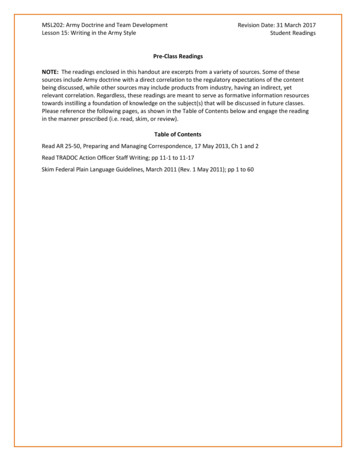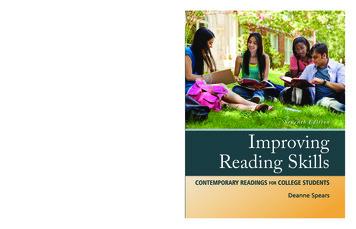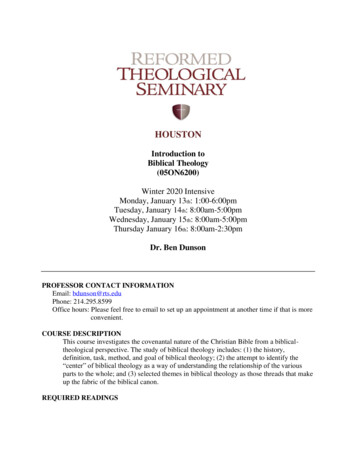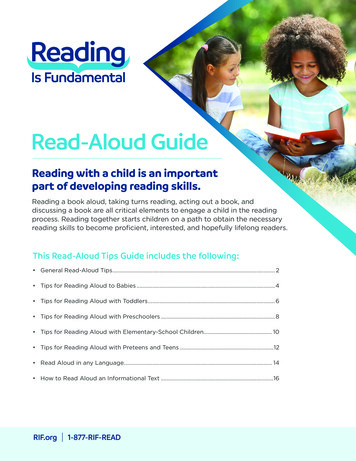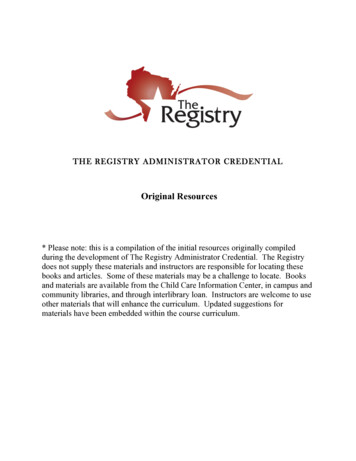
Transcription
Chapter 6. Readings on ReadingThis chapter serves as a bridge between Part One of this textbook, which includes the instruction, and Part Two, which includes the readings on technology and related assignments. You’ll findselections on the subject of reading written by scholar-teachers within the fields of composition,rhetoric, literacy studies, and education. These are peer-reviewed scholarly essays that have beenpublished in some of the most prestigious scholarly journals. In these essays, scholars address arange of issues surrounding reading. Some essays describe research on how well students read andwhat motivates students to read. Others explore the most effective ways of defining and teachingreading in writing classes, and others, still, address the difficulties students have transitioning fromthe expectations of high-school-level reading to those of college-level reading. Although you mayhave some difficulty reading these dense pieces—and are encouraged to use the reading strategiesoutlined in Chapter 2—the subjects these essays address should be rather familiar to you. After all,students, and particularly first-year students, figure prominently in these pieces. At the end of thischapter you will find general questions about the reading selections that will help you understand,respond, and apply what you have learned from these pieces. These essays will support your understanding of the very concept of reading and set you on a path toward becoming a more reflectivereader.Prior to Reading Each Selection in This ChapterLook at the questions at the end of the chapter. What are you expected to do after reading theselections? In other words, what are your purposes for reading? Although you will be asked to applyparticular reading strategies in order to complete some of the tasks, other questions will leave thechoice of strategy up to you. Refer to the descriptions of the reading strategies in Chapter 2 anddecide which will be most useful in helping you accomplish those tasks.57
58 Chapter 6College English Volume 41, Number 6, February 1980A Relationship between Reading and Writing:The Conversational Model1Charles Bazerman2The connection between what a person reads and what that person then writes seems so obvious asto be truistic. And current research and theory about writing have been content to leave the relationship as a truism, making no serious attempt to define either mechanisms or consequences of theinterplay between reading and writing. The lack of attention to this essential bond of literacy resultsin part from the many disciplinary divorces in language studies over the last half century: Speech hasmoved out taking Rhetoric with it; Linguistics has staked a claim to all skilled language behavior, buthas attended mostly to spoken language; Sociology and Anthropology have offered more satisfactorylodgings for the study of the social context and meaning of literacy; and English has gladly rid itselfof basic Reading to concern itself purely with the higher reading of Literary Criticism. Writing in itsthree incarnations as basic composition, creative writing, and the vestigial advanced exposition, remains an unappreciated houseguest of Literature. All these splits have made it difficult for those of usinterested in writing to conceive of writing in terms broad enough to make essential connections: ouraccommodation has been to focus on the individual writer alone with the blank piece of paper andto ignore the many contexts in which the writing takes place. This essay will review developments incomposition in light of this difficulty, propose a remedy in the form of a conversational model for theinterplay of reading and writing, and then explore the implications of the model for teaching.One of the older views, with ancient antecedents, held that a neophyte writer was an apprenticeto a tradition, a tradition the writer became acquainted with through reading. The beginning student studied rules and practiced set forms derived from the best of previous writing; analysis andimitation of revered texts was the core of more advanced study of writing. The way to good writingwas to mold oneself into the contours of prior greatness. Although current composition theorylargely rejects this tradition/apprentice model as stultifying, teachers of other academic disciplinesstill find the model attractive, because writing in content disciplines requires mastery of disciplinaryliterature. The accumulated knowledge and accepted forms of writing circumscribe what and how a1Citation: Bazerman, Charles. “A Relationship between Reading and Writing: The Conversation Model.” College English, vol. 41, no. 6, 1980, pp. 656‒661.2Charles Bazerman is an associate professor of English at Baruch College of the City University of New Yorkand serves as co-chair of the CUNY Association of Writing Supervisors. He has published on a number of literary topicsas well as composition, and he is currently investigating the character of writing in academic disciplines.
Readings on Reading 59student may write in disciplines such as history, biology, and philosophy.Recent work in composition has chosen instead to emphasize the writer’s original voice, whichhas its source in an independent self. The model of the individual writer shaping thought throughlanguage informs recent investigations into the composing process, growth of syntactic maturity,and the source of error. We have aided the student in the struggle to express the self by revealingthe logic of syntax, by asking for experiential and personal writing, and by offering techniques forpre-writing and invention to help the student get closer to the wellsprings of thought that lie inside.Even traditional rhetoric finds its new justification in the reflection of organic psychological realities. By establishing the importance of the voice of the writer and the authority of personal perception, we have learned to give weight to what the student wants to say, to be patient with the complexprocess of writing, to offer sympathetic advice on how to rather than what not to, and to help thestudent discover the personal motivations to learn to write.Yet the close observation of the plight of the individual writer has led us to remember that writing is not contained entirely in the envelope of experience, native thought, and personal motivationto communicate. Communication presupposes an audience, and deference to that audience has ledto a revived concern for the forms of what is now called Standard Written English. E. D. Hirsch,in The Philosophy of Composition (Chicago: University of Chicago Press, 1977), locates the entirephilosophy in readability; that is, concern for the audience. We have also noticed that most writingour students do during college is in the context of their academic studies; interest in writing acrossthe curriculum has been the result. In the most thoughtful study coming out of this approach, TheDevelopment of Writing Abilities (11-18) (London: Macmillan, 1975), James Britton and his colleaguesbegin to notice that students use readings, but in personal and original ways, in order to write fortheir academic courses. “Source-book material may be used in various ways involving different levels of activity by the writer” (p. 23).We may begin to understand those “various ways” and “different levels of activity” Britton refersto if we consider each piece of writing as a contribution to an on-going, written conversation. Conversation requires absorption of what prior speakers have said, consideration of how earlier comments relate to the responder’s thoughts, and a response framed to the situation and the responder’s purposes. Until a final statement is made or participants disengage themselves, the process ofresponse continues. The immediacy of spoken conversation does, I must admit, differ significantlyfrom the reflectiveness of written conversation, but the differences more illuminate the special character of writing than diminish the force of the model. Speech melody, gestural communication,rapidly shifting dynamics, and immediate validation on one side are set against explicitness, development, complexity, contemplation, and revision on the other. The written conversation also maybring together a more diffuse range of participants than the spoken one, although the example ofan exchange of office memos or the closed circle represented in professional journals indicates that
60 Chapter 6such is not always the case. Further, in spoken conversation the makers of previous comments aremore likely to be the auditors of the response. But again the counter-examples of the teacher whoturns one student’s question into the occasion for a lecture to the entire class, or the printed backand forth of a literary war, suggest that this distinction should not be oversimplified.The conversational model points up the fact that writing occurs within the context of previous writing and advances the total sum of the discourse. Earlier comments provide subjects at issue, factual content, ideas to work with, and models of discourse appropriate to the subject. Latercomments build on what came before and may, therefore, go farther. Later comments also definethemselves against the earlier even as they dispute particulars, redefine issues, add new material, orotherwise shift the discussion.If as teachers of writing we want to prepare our students to enter into the written interchangesof their chosen disciplines and the various discussions of personal and public interest, we mustcultivate various techniques of absorbing, reformulating, commenting on, and using reading. In thetradition/apprentice model such skills were fostered only implicitly under the umbrella assignmentof the research paper, but they were not given explicit, careful attention. Only access to the tradition(information gathering) and acknowledgement of the tradition (documentation) were the foci ofinstruction. In the newer model of the voice of the individual self, assignments such as the researchpaper are superfluous, remaining only as vestiges of former syllabi or as the penance imposed on aservice department. The model of the conversation, however, suggests a full curriculum of skills andstages in the process of relating new comments to previously written materials. The following partialcatalogue of stages, skills, and assignments points toward the kinds of issues that might be addressedin writing courses. The suggestions are in the form of a framework rather than of specific lessonsin order to leave each teacher free to interpret the consequences of the model through the matrixof individual thoughts, experiences, and teaching styles. Similarly the teacher will need to interpretthe model through those conversations that are most familiar and important to students. Given thediversity of existing written conversations and the variety of individual responses, it is not profitableto prescribe a single course for everyone.Intelligent response begins with accurate understanding of prior comments, not just of the factsand ideas stated, but of what the other writer was trying to achieve. A potential respondent needsto know not just the claims a writer was making, but also whether the writer was trying to callestablished beliefs into question or simply add some detail to generally agreed upon ideas. The respondent needs to be able to tell whether a prior statement was attempting to arouse emotions or tocall forth dispassionate judgment. The more we understand of the dynamics as well as the contentof a conversation, the more we have to respond to. Vague understanding is more than careless; itis soporific. Particular writing assignments can help students become more perceptive readers andcan help break down the tendency toward vague inarticulateness resulting from purely private read-
Readings on Reading 61ing. Paraphrase encourages precise understanding of individual terms and statements; the act oftranslating thoughts from one set of words to another makes the student consider exactly what wassaid and what was not. Summary reveals the structure of arguments and the continuity of thought;the student must ferret out the important claims and those elements that unify the entire pieceof writing. Both paraphrase and summary will also be useful skills when in the course of makingoriginal arguments the student will have to refer to the thoughts of others with some accuracy andefficiency. Finally, having students analyze the technique of writing in relation to the writing’s apparent purpose will make students sensitive to the ways writing can create effects that go beyond theovert content. Analysis of propaganda and advertising will provide the extreme and easy cases, butanalysis of more subtle designs, such as that of legal arguments or of reports of biological research,will more fully reveal the purposive nature of writing.The next stage, reacting to reading, gives students a sense of their own opinions and identitydefined against the reading material. As they try to reconcile what they read with what they alreadythink, students begin to explore their assumptions and frameworks of thought. At first their responses may be uninformed, either fending off the new material or acquiescing totally to what appearsto be the indisputable authority of the printed word. But with time and opportunities to articulatetheir changing responses, students can become more comfortable with the questions raised by theirreading; they enter into a more dialectical relationship with those who have written before. Priorassimilated reading becomes grist for processing new reading. Three kinds of exercise encouragethe development of more extensive and thoughtful reactions: marginal comments on reading, reading journals, and informal reaction essays. From early in the semester teachers should encouragestudents to record their thoughts about the reading in marginal notes. The teacher must be carefulto distinguish this kind of reaction annotation from the more familiar study skills kind of contentannotation, perhaps by suggesting that content annotations go on the inside margin and reactionsgo on the wider outside margins. This reaction in the margins increases the student’s awareness ofmoment-by-moment responses to individual statements and examples. Reading journals writtenafter each day’s reading give the student additional room to explore the immediate responses atgreater length and to develop larger themes. Again the teacher must insist on the distinction between content summaries and reactions, no matter how tentative the latter may at first be. Finally,the informal response essay allows the student to develop a single reaction at length, perhaps drawing on a number of related, more immediate responses. Here the teacher should make sure that theresponse maintains contact with issues growing out of the reading and does not become purely arhapsody on a personal theme unrelated to the reading. For all three types of assignment the teachercan refer the student to previously held opinions, experiences, observations, and other readings asstarting points for reactions. As students become more sensitive to their responses to reading, theywill spontaneously recognize likely starting points.
62 Chapter 6Developing reactions leads to more formal evaluation of reading, measuring what a book or article actually accomplishes compared to its apparent ambitions, compared to reality, and compared toother books. The evaluative review, if treated as more than just a notice covered with a thin wash ofreaction, is an effective exercise, for it requires the student both to represent and to assess the claimsof the book or article. The reader’s reaction to the book is also significant to the evaluation, for ifthe reader finds herself laughing when she should be nodding in assent, the book has failed to meetat least some of its purposes. Another kind of evaluative essay measures the claims of the readingagainst observable reality. The data the student compares to the book’s claims may be from priorexperience, new observations, formal data-gathering using social science techniques, or technicalexperiments. Here the teacher may discuss the variety of purposes, criteria, and techniques of datagathering in different academic disciplines as well as other human endeavors. Finally the studentmay be asked to compare the claims and evidence of a number of different sources. In this kind ofexercise the students have to judge whether there is agreement, disagreement, or merely discussionof different ideas; then the student must identify on what level the agreement or disagreement occurs, whether of simple fact, interpretation, idea, or underlying approach; and finally he must determine how the agreements can be fitted together and the disagreements reconciled or adjudicated.Conflicts cannot, of course, always be resolved, but students become aware of the difficulties of evaluation. Comparison of matched selections, reports requiring synthesis, reviews of literature, andannotated bibliographies are all assignments compatible with this last purpose. Reviews of literatureand annotated bibliographies also give the student a coherent picture of how previous commentsadd up in pursuit of common issues.Students can then begin to define those issues they wish to pursue and to develop informedviews on those issues. Two kinds of exercise, definitions of problem areas and research proposals,require the student to identify some issue he or she would like to know more about, to assemble theprior statements relevant to the issue, and to indicate the limitations of those sources. The proposalrequires the further task of planning how the gap of knowledge in the literature can be overcome.Problem definitions and proposals are early stages of the familiar assignment of the research paper.Also familiar is the teacher’s disappointment upon receiving a derivative research report instead ofan original, informed view in the form of a research essay. The use of preparatory assignments—notjust the proposal, but also progress reports, reflections on the evidence, hypothesis testing and ideasketches—will help remind the student of the original goal of the work while encouraging creativeand detailed use of the source material. Prior instruction in the skills discussed above will also insure that the student knows how to use reading to form independent attitudes toward the sourcesand so facilitate the development of original theses. Other, more specific exercises that set the conditions for the development of informed views involve setting factual and theoretical sources againsteach other. Three case studies can be compared to elicit general patterns, or one writer’s theories can
Readings on Reading 63be measured against another’s factual material. These two assignments are, in fact, forms of criticalanalysis using a coherent set of categories derived from a theoretical standpoint to sort out specifics.Such exercises show the student the many uses of source material beyond simple citation of authority in support of predetermined opinion.The independent, critical standpoint the student develops with respect to reading other people’sworks can also help the student frame and revise his or her own writing to be a purposeful andappropriate contribution to an on-going conversation. Consideration of the relationship to previous statements will help the student decide what techniques are likely to serve new purposes. Willa redefinition of basic concepts, the introduction of a new concept, or the close analysis of a casestudy best resolve confusion? Or perhaps only a head-on persuasive argument will serve. Further,knowledge of the literature likely to have been read by an audience helps a writer determine whatneeds to be explained at length and what issues need to be addressed.The model of written conversation even transforms the technical skills of reference and citation.The variety of uses to be made of quotation, the options for referring to others’ ideas and information (e.g., quotation, paraphrase, summary, name only), and the techniques of introducing anddiscussing source materials are the tools which allow the accurate but pointed connection of one’sargument to earlier statements. The mechanics of documentation, more than being an exercise inintellectual etiquette, become the means of indicating the full range of comments to which the newessay is responding.When we ask students to write purely from their selves, we may tap only those prior conversations that they are still engaged in and so limit the extent and variety of their thinking and writing.We can use reading to present new conversational opportunities that draw the students into widerpublic, professional, and academic communities. Thus the students will learn to write within theheavily literate contexts they will meet in college and later life. Whether writing tasks are explicitlyembedded in prior written material—a review of literature, a research paper, or a legal brief—orwhether they are only implicitly related to the thought and writing of others, as in critical analysesor matters of public debate, if students are not taught the skills of creating new statements throughevaluating, assimilating, and responding to the prior statements of the written conversation, weoffer them the meager choice of being parrots of authority or raconteurs stocked with anecdotes forevery occasion. Only a fortunate few will learn to enter the community of the literate on their own.
64 Chapter 6Language Arts, Volume 60, Number 5, May 1983Toward a Composing Model of Reading1Robert J. Tierney and P. David Pearson2We believe that at the heart of understanding reading and writing connections one must beginto view reading and writing as essentially similar processes of meaning construction. Both are actsof composing.3 From a reader’s perspective, meaning is created as a reader uses his background ofexperience together with the author’s cues to come to grips both with what the writer is gettinghim to do or think and what the reader decides and creates for himself. As a writer writes, she usesher own background of experience to generate ideas and, in order to produce a test which is considerate to her idealized reader, filters these drafts through her judgments about what her reader’sbackground of experiences will be, what she wants to say, and what she wants to get the reader tothink or do. In a sense both reader and writers must adapt to their perceptions about their partnerin negotiating what a text means.Witness if you will the phenomenon which was apparent as both writers and readers were askedto think aloud during the generation of, and later response to, directions for putting together a waterpump (Tierney at al., in press; Tierney 1983). As Tierney (1983) reported:At points in the text, the mismatch between readers’ think-alouds and writers’ thinkalouds was apparent: Writers suggested concerns which readers did not focus upon (e.g.,I’m going to have to watch my pronouns here . . . . It’s rather stubborn—so I better tellhow to push it hard . . . he should see that it looks very much like a syringe), and readersexpressed concerns which writers did not appear to consider (I’m wondering why I shoulddo this . . . what function does it serve). As writers thought aloud, generated text, andmoved to the next set of sub-assembly directions, they would often comment about thewriters’ craft as readers might (e.g., no confusion there . . . . That’s a fairly clear descriptor . . and we’ve already defined what that is). There was also a sense in which writers marked1Citation: Tierney, Robert J. and P. David Pearson. “Toward a Composing Model of Reading.” Language Arts,vol. 60, no. 5, May 1983 pp. 568‒580.2Robert J. Tierney and P. David Pearson are associated with the Center for the Study of Reading at the University of Illinois at Urbana-Champaign.3This work was supported in part by the National Institute of Education under Contract No. NIE 400-81-0030.Selected aspects of relevance to the model are also discussed in a paper “On Becoming a Thoughtful Reader: Learning toRead Like a Writer” by P. David Pearson and Robert J. Tierney and “Writer Reader Interactions: Defining the Dimensions of Negotiation” by Robert J. Tierney. Special Thanks go to T. Rogers and others, including A. Crismore, L. Fielding,J. Hansen, and J. Harste for their reactions and help with the paper.
Readings on Reading 65their compositions with an “okay” as if the “okay” marked a movement from a turn asreader to a turn as writer. Analyses of the readers’ think alouds suggested that the readersoften felt frustrated by the writers’ failure to explain why they were doing what they weredoing. Also the readers were often critical of the writer’s craft, including writers’ choice ofwords, clarity, and accuracy. There was a sense in which the readers’ think alouds assumeda reflexive character as if the readers were rewriting the texts. If one perceived the readersas craftpersons, unwilling to blame their tools for an ineffective product, then one mightview the readers as unwilling to let the text provided stand in the way of their successfulachievement of their goals or pursuit of understanding. (p. 150)These data and other descriptions of the reading act (e.g., Bruce 1981; Collins, Brown and Larkin1970; Rosenblatt 1976, 1980; Tompkins 1980) are consistent with the view that texts are written andread in a tug of war between authors and readers. These think-alouds highlight the kinds of internalstruggles that we all face (whether consciously or unconsciously) as we compose the meaning of atext in front of us.Few would disagree that writers compose meaning. In this paper we argue that readers alsocompose meaning (that there is no meaning on the page until a reader decides there is). We willdevelop this position by describing some aspects of the composing process held in parallel by reading and writing. In particular, we will address the essential characteristics of effective composing:planning, drafting, aligning, revising and monitoring.PlanningAs a writer initially plans her writing, so a reader plans his reading. Planning involves two complementary processes: goal-setting and knowledge mobilization. Taken together, they reflect somecommonly accepted behaviors, such as setting purposes, evaluating one’s current state of knowledgeabout a topic, focusing or narrowing topics and goals, and self-questioning.Flower and Hayes (1981) have suggested that a writer’s goals may be procedural (e.g., how do Iapproach this topic), substantive (e.g., I want to say something about how rockets work), or intentional (e.g., I want to convince people of the problem). So may a reader’s goals be procedural (e.g.,I want to get a sense of this topic overall), substantive (e.g., I need to find out about the relationshipbetween England and France), or intentional (e.g., I wonder what this author is trying to say) orsome combination of all three. These goals can be embedded in one another or addressed concurrently; they may be conflicting or complementary. As a reader reads (just as when a writer writes)goals may emerge, be discovered, or change. For example, a reader or writer may broaden, fine tune,redefine, delete, or replace goals. A fourth grade writer whom we interviewed about a project he had
66 Chapter 6completed on American Indians illustrates these notions well: As he stated his changing goals, “ . . I began with the topic of Indians but that was too broad, I decided to narrow my focus on Hopis,but that was not what I was really interested in. Finally, I decided that what I really wanted to learnabout was medicine men . . . I really found some interesting things to write about.” In coming togrips with his goals our writer suggested both procedural and substantive goals. Note also that herefined his goals prior to drafting. In preparation for reading or writing a draft, goals usually change;mostly they become focused at a level of specificity sufficient to allow the reading or writing to continue. Consider how a novel might be read. We begin reading a novel to discover the plot, yet findourselves asking specific questions about events and attending to the author’s craft—how she usesthe language to create certain effects.The goals that readers or writers set have a symbiotic relationship with the knowledge they mobilize, and together they influence what is produced or understood in a text (Anderson, Reynolds,Schallert and Goetz 1977; Anderson, Pichert and Shirey 1979; Hays and Tierney 1981; Tierney andMosenthal 1981). A writer plans what she wants to say with the knowledge resources at her disposal.Our fourth grade writer changed his goals as a function of the specificity of the knowledge domainto which he successively switched. Likewise readers, depending on their level of topic knowledgeand what they want to learn from their reading, vary the goals they initiate and pursue. As an example of this symbiosis in a reader, consider the following statement from a reader of Psychology Today.I picked up an issue of Psychology Today. One particular article dealing with women inmovies caught my attention. I guess it was the photos of Streep, Fonda, Lange, that interested me. As I had seen most of their recent movies I felt as if I knew something aboutthe topic. As I started reading, the author had me recalling my reactions to these movies(Streep in “Sophie’s Choice,” Lange in “Tootsie,” Fonda in “Julia”). At first I intended toglance at the article. But as I read on, recalling various scenes, I became more and moreinterested in the author’s perspective. Now that my reactions were nicely mobilized, thisauthor (definitely a feminist) was able to convince me of her case for stereotyping. I hadnot realized the extent to which women are either portrayed as the
Chapter 6. Readings on Reading This chapter serves as a bridge between Part One of this textbook, which includes the instruc-tion, and Part Two, which includes the readings on technology and related assignments. You’ll find selections on the subject of reading writ

